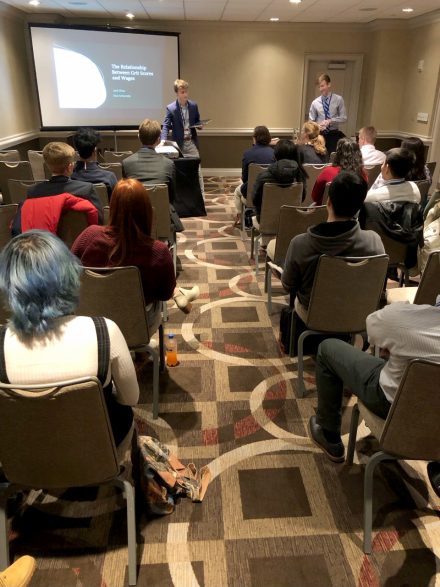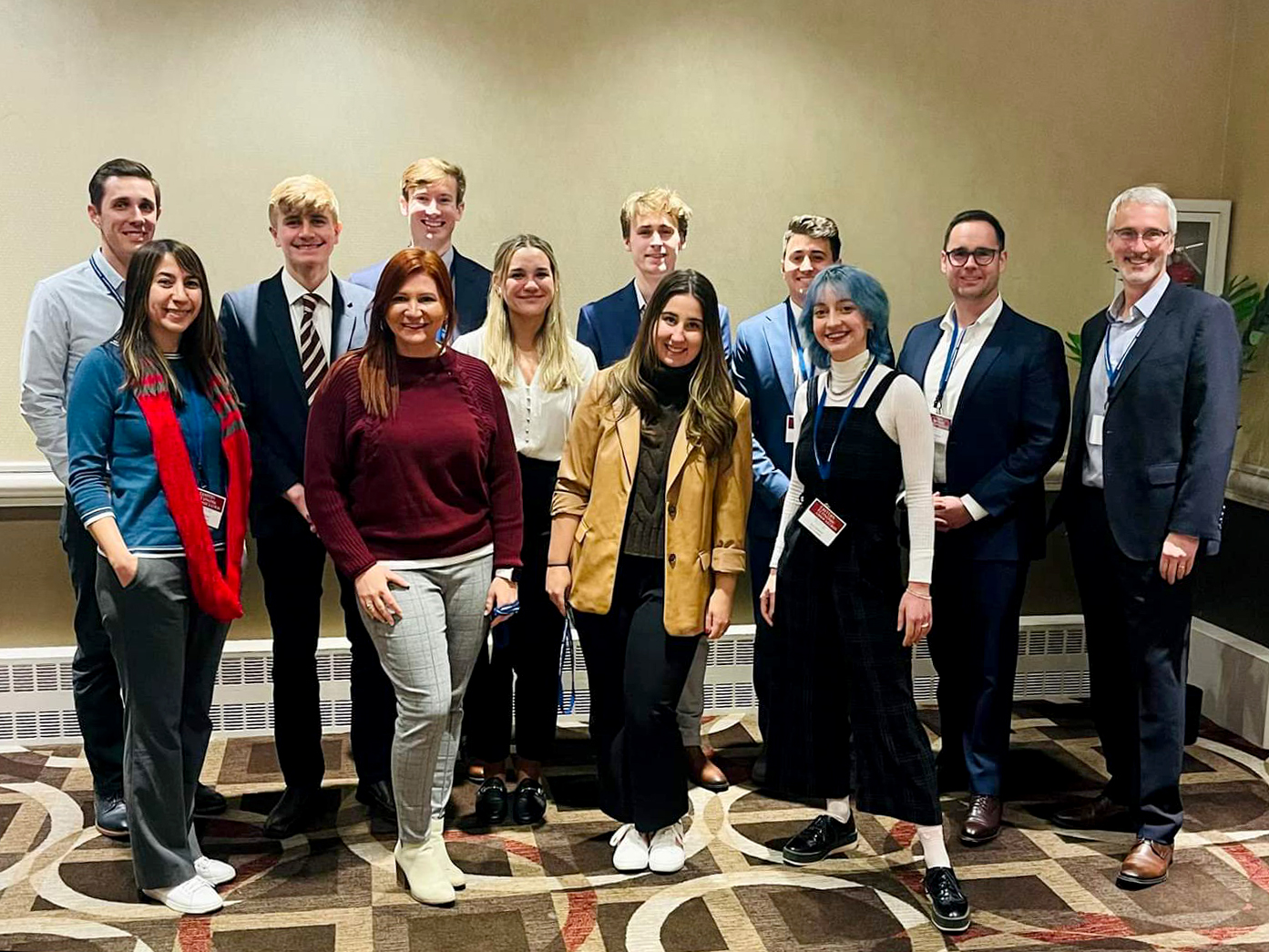The Eastern Economic Association held its annual conference this winter in New York City where seven students majoring in economics or economic consulting presented their undergraduate research.
A team of Elon University students traveled to New York City in late February for a national conference that offers opportunities for attendees to present undergraduate research and network with some of the nation’s leading economic scholars.
Elon’s students participated in eight undergraduate research sessions along with students from several colleges and universities, including Boston University, UNC Chapel Hill, Notre Dame, and Villanova, at the 49th annual conference of the Eastern Economic Association.

Issues in Political Economy – an undergraduate research journal co-edited by Elon University and the University of Mary Washington – has hosted undergraduate research sessions at this conference for 27 years.
Headquartered in the Anisfield School of Business Ramapo College of New Jersey, the Eastern Economic Association is a nonprofit corporation created to “promote educational and scholarly exchange on economic affairs.” It publishes the Eastern Economic Journal and holds annual conferences to achieve those goals.
The conference was held Feb. 23-26, 2023, at the Sheraton Times Square.
Abstracts of Elon University Student Research (Faculty Mentors in Parentheses)
Men’s and Women’s Work Burden Convergence: The Covid-19 Recession
Martin C. Adams (Professor Tina Das)
According to literature, previous recessions have caused an acceleration on the convergence of women’s and men’s unemployment rates. As men experienced higher levels of job loss, women experienced higher levels of employment in the workforce. In this study I will examine whether the Covid-19 recession declined the disparity between men and women paid and unpaid work burdens. I will analyze how market work (paid work), non-market work (unpaid work), leisure, and personal care has been affected by the Covid-19 recession and whether it has truly contributed to a convergence in the disparity of gender equality in the workforce. I will be using data from the American Time Use Survey (ATUS), analyze people from the ages of 18-65, and exclude men and women who work for armed forces, are full-time students, self-employed, or employed without pay. Based on previous literature and preliminary research, I hypothesize that the Covid-19 recession did cause an accelerated convergence between men’s and women’s work burden. Based on my hypothesis, this study could be useful to policy makers when considering differential impacts of economic recessions across different sexes when developing policies to offset the negative impact of economic downturns.
Wage inequality and discrimination in the LGBTQIA+ community
Evangelia Nefeli Sklaveniti (Professor Steve DeLoach)
The LGBTQ+ adult population includes only 5.6% of the US population, making many people ignorant of the struggles and framing this topic as insignificant for many. A recent study by The Human Rights Campaign (2022) investigated the wage gap between full-time LGBTQ+ workers and cis/straight workers in the US. The findings reported the median earnings of the LGBTQ+ community to be about 90% less than the median weekly wage a typical cis/straight worker earns in the US. The importance and awareness of discrimination in the workplace are essential, for a safe and equality-promoting working environment that leads to passion and maximization of productivity. The purpose of this paper is to study whether a wage gap exists for LGBTQIA+ individuals and its extent. Specifically, this paper examines the US sexuality wage gap by comparing the weekly US wages of gay cis men/ straight cis men and straight cis women/ lesbian cis women. Controlling for industry, education, age, race, and experience, three models are going to be applied in this study. The baseline model is a Mincerian Wage Model. The Mincerian Wage Model, is a single equation that explains wage as a function of educational attainment and years of experience, which will be used as the control base for the main regression. After estimating separate regressions for cis/straight and LGBTQ+ workers, the Oaxaca-Blinder decomposition will be used to measure how much of the wage gap is attributed to factors such as skill or discrimination. Data come from IPUMS USA focusing on the year 2019, with a sample size of 2,185,179.
The Influence of Grade Inflation on College Major Selection Choice and Graduation Rates
James D. Grant (Associate Professor Katy Rouse)
College graduation rates have been steadily increasing since the 1990s, with institutional factors and student characteristics playing almost no role in explaining this change (Dennings et al., 2022). Instead, research suggests grade inflation in higher education largely accounts for the rise in graduation rates. Moreover, other studies have demonstrated that grades, expected grades, and grade awareness (e.g., publicly available median grades) all significantly influence course enrollment and major selection in higher education. This paper, using repeated cross-sectional student-level data from a mid-sized, private liberal arts institution in the southeast, studies the existence and impact of grade inflation between 1998 and 2022 on graduation rates and major course selection. First, I establish and identify the existence of grade inflation by regressing college GPA on precollegiate measures of achievement (SAT, ACT scores), demographic characteristics, institutional characteristics, and dummy variables for each cohort. Then, I follow the Blinder-Oaxaca decomposition approach used by Dennings et al. (2020) to evaluate the relationship between grade inflation and college graduation rates. Finally, I evaluate the role of grade inflation in explaining college major choice. The analysis is reported through a breakdown of educational departments, and can be further analyzed by race/ethnicity, gender, etc. Results for this study are yet to be fully analyzed, reported, and discussed.
Mental Wellbeing on Outcomes
Hailey Lynn Crawford (Professor Steve DeLoach)
Clinical depression is the leading cause of employment disability globally. Depression has tangible impacts on mental health as well as career related outcomes. The effect of adolescent depression has been shown to affect vocational advancement through decreased educational attainment, increased absenteeism (productivity), lower salary, and decreased labor force participation. The purpose of this research is to analyze the effects of adult mental wellbeing on labor market outcomes. These outcomes will be in the timeframe of young adulthood, where depression and major life events are most frequent. With the increased prevalence of mental health occurrences in the U.S., quantifying the direct impact of depressive symptoms on the labor market outcomes is important as it can help to allocate mental health resources and treatment.
How Do Wage Freezes for Michigan Public School Teachers Affect School Performance?
Christopher Robert Boyette (Associate Tonmoy Islam)
Michigan public schools have been hit particularly hard by school funding issues. As a result, many public school districts have resulted to freezing teacher salaries for a certain number of years. Economic theory on the issue states that while job performance may not be directly tied with wages, there is some indication that school performance can be impacted by teacher wages and classroom size. However, little to no studies have been done on whether stagnant wages impact job productivity in the education sector. As a result, the focus of this paper is what effect teacher salary freezes have on student achievement in Michigan public schools. To accomplish this, comparison groups will then be established using school districts with no instances of salary freeze and school districts that have experienced teacher salary freezes during the same period. Then, difference-in-differences models will be formed that compare school performance between the two groups in the form of standardized tests scores for elementary, middle, and high schoolers. After the regressions are analyzed, a conclusion on the effects of teacher salary freezes on school performance will be developed.

The Relationship Between Grit Scores and Wages
John Davis Shea (Professor Steve DeLoach)
The determinants of success have long been a field of study. Angela Duckworth’s research into grit, defined as passion and perseverance in the face of obstacles, is a novel method to view the catalyst behind successful people. The benefits of high ratings of Grit have been well documented on an individual’s academic achievement, but little has been done to extrapolate the findings into the labor market. The purpose of this study was to determine the effect that young adult Grit levels has on wages earned in adulthood. The data for this paper comes from the databases of the National Longitudinal Survey of Youth. Controlling for differences in educational attainment, cognitive skills, and health status, I find that an increase of one standard deviation in Grit levels leads to a 7.7% higher yearly salary for men, and a 10.5% higher yearly salary for women.
Redlining Effects on Student Achievement in Massachusetts Public Schools
Courtney Beth Shanley (Assistant Professor Cora Wigger)
In the 1930s within the United States, a federal housing agency, Homeowners’ Loan Corporation (HOLC), created four-letter colored-coded maps with grades A (best), B (still desirable), C (declining), and D (hazardous) depicting the areas’ mortgage security. The practice of redlining was outlawed in 1968, however, it has shaped the demographic and wealth patterns of American communities today. About 75% of neighborhoods that were previously graded or “redlined” on maps created more than 80 years ago continue to struggle economically. Students in these economically challenged neighborhoods often have fewer resources available to them leading to less student achievement in those areas. In this study, I explore the impacts of redlining on student achievement within Massachusetts public schools using panel data from the Massachusetts Department of Elementary and Secondary Education (DESE), National Center for Education Statistics (NCES), and National Assessment of Education Progress (NAEP) along with HOLC 1930s redlined maps. Massachusetts Comprehensive Assessment System (MCAS) standardized test scores from 1998 to 2019 are used as a proxy for student achievement. To determine causality, a year fixed-effects model was run, analyzing the treatment group, redlined schools, versus the control group, non-redlined schools, while controlling for HOLC grade, school grade, subject of MCAS test, and year. Due to the nuance between the distinction of grades A-D, I implement a thirteen-point system using pluses and minuses as the significance between the letters is not equal. This study only examines the effects on public schools within Massachusetts excluding vocational and non-public charter schools. I find that schools that were previously redlined performed lower than schools that were not previously redlined as the percentage of students who scored proficient or advanced on the MCAS was less. Moreover, schools rated “A-B” had less significant impacts to student achievement than schools rated “C-D.”



